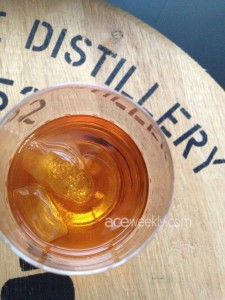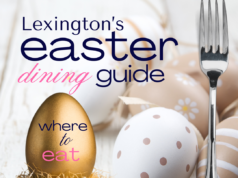BY HEATHER C. WATSON
It’s a great time to be a bourbon lover.
Kentucky’s signature spirit is popping up everywhere. The new batch of craft label bourbons provides unique flavor profiles. Chefs are putting new spins on bourbon recipes, and there seem to be more ways to enjoy bourbon than ever before.



Later this month, Midway’s Holly Hill Inn will get in the bourbon spirit, as it hosts the first meeting of the 1785 Bourbon Society. The group, described as a “bourbon appreciation society” by Holly Hill Inn Chef Ouita Michel, will be led by “Bourbon Master” Tim Knittel, a professional bourbon educator.
In the spirit of all things bourbon, Tim answered a few questions for us about the 1785 Bourbon Society, bourbon’s latest boom, and a few ways that we can all enjoy bourbon a little more.
Ace: First of all, you have to have the coolest job title of all time. Tell us a little bit about being a professional bourbon educator.
Tim: Yeah, it’s a pretty sweet gig. I spend a surprising amount of time on research and it’s not all just tasting bourbon. (Although there is a fair amount of that, too!) Keeping up with the industry is full time work and there’s constantly new research coming out about bourbon’s history, the chemistry of spirit making and of course new culinary and mixology techniques.
My job is to provide the education that consumers are now demanding. I organize and lead tasting classes and bourbon societies for the general public and appear for private events, like corporate parties or charity fundraisers.
I also work with craft and micro-distillery producers. I help them develop their own palates to effectively judge their products and learn how their products fit into the marketplace.
Ace: Tell us a little about the 1785 Bourbon Society — how it came together, the programs you’re hosting, etc.
Tim: Chef Ouita Michel has desired to have a Bourbon Society to complement Holly Hill Inn’s Wine Guild for quite some time. This year everything fell into place.
The mission of the 1785 Bourbon Society is to educate bourbon drinkers from novice to aficionado all about this unique spirit – including origin and history, palate training, mixology, food pairings and cooking with bourbon as an ingredient. To this end, we will explore bourbons common and rare, popular and unique. We will bring the well-regarded standards of the Holly Hill Inn – local, authentic, culinary and gourmet – to our path of investigation of this Kentucky-created spirit.



Our programs will be varied. We’ll touch on history and the evolution of bourbon from un-aged sweet mash corn whiskey to modern ultra-premium bourbons. We’ll cover palate training including flavor wheels, aromatic and culinary aids and reference whiskeys. If you attend all of our classes, you’ll learn to experience bourbon like a professional taster! We’ll intersperse this series with classes on mixology and bourbon culinary arts, and you can expect a few more extravagant events to appear as well.
Ace: It seems like, every day, we’re seeing so many new avenues for enjoying bourbon. Tasting menus are popping up, pairing bourbon with food and including it in unique new recipes. There are events, landmarks, and societies. But, the thing is, bourbon has always tasted good. Why bourbon? Why now?
Tim: I don’t know that I would say that bourbon has always tasted good. People debate over which historic whiskeys (pre-1964) can legitimately be called bourbon, but I think any historic whiskey that meets the bourbon standards is legit. That gives us 200+ years’ worth of American whiskeys to include. Whiskeys in general have a much longer history of quality but not all whiskeys are bourbons.
The early corn whiskeys were nothing like today’s bourbons. Even the barrel-aged ones had little color and rarely contained rye or wheat so their flavors would be completely different.
Bourbon-making technology has evolved dramatically. The sour mash process, new methods of toasting and charring barrels, the column still, hybridization of corn, new yeast strains and even advances in sanitary conditions have all contributed to changes in the flavor of bourbons.
Modern bourbons like Four Roses Small Batch and Woodford Reserve have carefully crafted flavors. Experimental bourbons like Corsair’s Grainiac are testing the limit of what you can play with during production and still make a real bourbon.
There’s a whole new category – “bourbons finished” – which includes Angel’s Envy, Woodford Reserve Double Oaked and Maker’s 46. These are aged with a change to the second barrel. They’re unique and unlike anything before them.
I think the bourbon boom is because there’s an explosion of bourbons and bourbon styles and so many have complex flavors. There’s so much to explore!
All of the things you mentioned – tasting menus, culinary pairings, events – have long been part of the wine tradition. Now bourbons have flavor profiles as sophisticated as wines and consumers are bringing their wine culture over to bourbons.
Ace: What is one misconception that the average bourbon drinker holds?
Tim: What drives me crazy is the misinformation about the chemistry of flavor profiles. It seems like a lot of people mistakenly believe that distillation removes everything except the alcohol and some water and so all the flavor comes from the barrel. Actually, only 40% to 80% of the flavor comes from the barrel and the rest is from the grain bill, fermentation, distillation and even the terrior.
To see this yourself, do a white vs. mature tasting. Taste several clear corn whiskeys together – say Buffalo Trace White Dog, Georgia Moon and Devil John Moonshine – and you can see the difference. Then if you taste the same spirit new vs. mature – maybe the Buffalo Trace White Dog and Buffalo Trace Bourbon – you can learn which flavors come from the barrel and which are from the new spirit.
There’s a lot more to the chemistry of it but that exercise is a great starting place.
The first meeting of the 1785 Bourbon Society will be held at Midway’s Holly Hill Inn on Friday February 22. Visit www.hollyhillinn.com for more information about joining the society.
This article also appears on page 14 of the February 7, 2013 print issue of Ace, and is part of Heather C. Watson’s ongoing Bourbons of the Bluegrass series.
Click here to subscribe to the Ace digital e-dition, emailed to your inbox every Thursday morning.








